Tuesday, September 29, 2009
Sunday, September 27, 2009
GOOGLE 11th BIRTHDAY
Happy 11th Birthday, Google. Nice Logo!



It’s Google’s 11th birthday on Sunday, September 27th: to celebrate, the company has changed its logo to a version that turns the letter “L” into the number 11. The logo is already viewable in Europe.
What’s interesting about the logo change is that Google’s official birthday is somewhat disputed: some often declare the company was born on September 15th 1997, the day the Google.com domain was registered. Meanwhile, Google filed for incorporation in September 1998: the papers were filed on September 4th, but Google has been known to celebrate on both September 7th and September 27th.
To explain the inconsistency, the company’s FAQ once famously read: “Google opened its doors in September 1998. The exact date when we celebrate our birthday has moved around over the years, depending on when people feel like having cake.” In recent years, Google has taken to changing its logo on September 27th, meaning this has been taken as the “official” date.
If you’d like to learn more about Google’s intriguing history, Google it. ![]()
Thursday, September 24, 2009
View Of Solar System In Sun
Mankind will not remain on Earth forever, but in its quest for light and space will at first timidly penetrate beyond the confines of the atmosphere, and later will conquer for itself all the space near the Sun. - Konstantin E. Tsiolkovsky
The Sun is the most prominent feature in our solar system. It is the largest object and contains approximately 98% of the total solar system mass. One hundred and nine Earths would be required to fit across the Sun's disk, and its interior could hold over 1.3 million Earths. The Sun's outer visible layer is called the photosphere and has a temperature of 6,000°C (11,000°F). This layer has a mottled appearance due to the turbulent eruptions of energy at the surface.
Solar energy is created deep within the core of the Sun. It is here that the temperature (15,000,000° C; 27,000,000° F) and pressure (340 billion times Earth's air pressure at sea level) is so intense that nuclear reactions take place. This reaction causes four protons or hydrogen nuclei to fuse together to form one alpha particle or helium nucleus. The alpha particle is about .7 percent less massive than the four protons. The difference in mass is expelled as energy and is carried to the surface of the Sun, through a process known as convection, where it is released as light and heat. Energy generated in the Sun's core takes a million years to reach its surface. Every second 700 million tons of hydrogen are converted into helium ashes. In the process 5 million tons of pure energy is released; therefore, as time goes on the Sun is becoming lighter.
The chromosphere is above the photosphere. Solar energy passes through this region on its way out from the center of the Sun. Faculae and flares arise in the chromosphere. Faculae are bright luminous hydrogen clouds which form above regions where sunspots are about to form. Flares are bright filaments of hot gas emerging from sunspot regions. Sunspots are dark depressions on the photosphere with a typical temperature of 4,000°C (7,000°F).
The corona is the outer part of the Sun's atmosphere. It is in this region that prominences appears. Prominences are immense clouds of glowing gas that erupt from the upper chromosphere. The outer region of the corona stretches far into space and consists of particles traveling slowly away from the Sun. The corona can only be seen during total solar eclipses.
The Sun appears to have been active for 4.6 billion years and has enough fuel to go on for another five billion years or so. At the end of its life, the Sun will start to fuse helium into heavier elements and begin to swell up, ultimately growing so large that it will swallow the Earth. After a billion years as a red giant, it will suddenly collapse into a white dwarf -- the final end product of a star like ours. It may take a trillion years to cool off completely.
| Sun Statistics | |
|---|---|
| Mass (kg) | 1.989e+30 |
| Mass (Earth = 1) | 332,830 |
| Equatorial radius (km) | 695,000 |
| Equatorial radius (Earth = 1) | 108.97 |
| Mean density (gm/cm^3) | 1.410 |
| Rotational period (days) | 25-36* |
| Escape velocity (km/sec) | 618.02 |
| Luminosity (ergs/sec) | 3.827e33 |
| Magnitude (Vo) | -26.8 |
| Mean surface temperature | 6,000°C |
| Age (billion years) | 4.5 |
| Principal chemistry Hydrogen Helium Oxygen Carbon Nitrogen Neon Iron Silicon Magnesium Sulfur All others | 92.1% 7.8% 0.061% 0.030% 0.0084% 0.0076% 0.0037% 0.0031% 0.0024% 0.0015% 0.0015% |
* The Sun's period of rotation at the surface varies from approximately 25 days at the equator to 36 days at the poles. Deep down, below the convective zone, everything appears to rotate with a period of 27 days.
WOODPECKER
| ||||
I felt even luckier when Handbook of the Birds of the World chose to publish this photo. Yet, although my cover letter described the circumstances, the eventual HBW text read: "Courtship displays of woodpeckers feature many elements that are used when showing aggression. The crown feathers are erected, the head raised and the wings drooped. Mate-feeding has been observed as part of the courtship ritual of only a few picid species, among them two Dinopium and two Melanerpes, but has only rarely been reported for the White-naped Woodpecker. Here, the red-crowned male of the latter has just presented his yellow-crowned mate with a beetle larva" (Vol. 7 at p. 376). Well, er, no. That's not what happened. But it's a nice photo anyway. | ||||
Acorn Woodpecker breeds cooperatively in communal groups featuring one or two lead males, a harem of females (mostly sisters), and youngsters from the previous year, one of the most unusual breeding systems in the natural world. Much of the research has occurred in the oak woodlands of Monterey County, California (where I live), and some fascinating facts are in MacRoberts & MacRoberts (1976), Koenig (1981), Koenig & Mumme (1987), and Stacey & Koenig (1984). Acorn Woodpeckers also collect and store acorns in "granary trees" against lean times (below). They are also frequent at my bird feeder, eating ordinary bird seed in times when acorn crops are poor. | ||||
 | ||||
Woodpeckers come in a great variety of shapes and colors. Flickers specialize in feeding on the ground, often focusing on ants. The Campo Flicker (below) of southern South America is such a species. Even it has the stiffly pointed specialized tail feathers that allow woodpeckers to perch vertically on tree trunks. | ||||
 | ||||
| Another specialized group are the sapsuckers of North America. They drill small holes into the cambium layer of living trees, causing sap to ooze forth slowly. They do this on a set of favored (usually young) trees and then follow their "trap line" from tree to tree, drinking the sap and sometimes consuming insects attracted to it. Birch, aspen, willow and orchard fruit trees are often favored, but they use some live oaks and key into certain non-native trees (like pepper trees). In all, their regular little square holes have been documented on over 250 species of native trees. The juvenal-plumaged Yellow-breasted Sapsucker (below left) is perched near an oft-drilled tree; this particular individual was a rare vagrant to coastal California. In the summer, Red-breasted Sapsucker (below right) breeds in the mountains and humid coastal forests of northern California. | ||||
| ||||
Woodpeckers are often termed "core species" because their presence is a fundamental requirement to the existence of a wide range of other birds. Woodpeckers drill new nest holes each year, and thus many old nest cavities are available for a entire suite of hole-nesting species. Many smaller species of North American swallow are dependent on woodpecker holes, as are virtually all the small owls, various bluebirds, and a huge array of small birds (wrens, chickadees) that use them advantageously. Thus the nest hole drilled by a Gila Woodpecker (above left), a small woodpecker of the American southwest, will be reused by other birds. The nest holes of large species like the Northern Flicker (above right) are particularly important for cavity-nesting species in western North America, and especially Purple Martins. | ||||
 | ||||
Alas, two the world's most awesome woodpeckers have apparently become extinct within my lifetime. The Ivory-billed Woodpecker Campephilus principalis of the southeastern U.S. and Cuba (which may have been a separate species) was always scarce, but loss of sufficient tracts of wild habitat doomed it by World War II. There have been widely reported recent sightings, but no substantive evidence has yet convinced the scientific community that the species is still extant. The Imperial Woodpecker C. imperialis of virgin pine forests in the Sierra Madre of nw. Mexico was even larger, and has not have been confirmed since 1957. It appears these two great birds have been lost forever. |
Types Of Flowers

Many millenniums flowers personify beauty at people, pleasure and perfection of the nature.
Flowers are giving to everybody, it does not matter who you are rich or poor, they give you that wonderful world, in which you feel yourself happy. Therefore people always tried to decorate with these surprising gifts of the nature not only celebratory and gala days of the life, but also everyday lives, which, as is known people have more even more full to feel pleasure of short-term life on the guilty Earth.
It seems that mother-nature has tried and has presented us these wonderful creations which a lot of millenniums ago bring in our life beauty, pleasure, and giving us good mood and emotional health at any time of the year.
In opinion of scientists there are more than 270 000 versions of colors. And each flower in his own way is beautiful and unusual and bears in itself a part of pleasure, to do our life more happier.
At all nations of the world flowers associate with heat, sun, spring and pleasure. And it is not important winter in the street or summer, autumn or spring. Flowers always remain symbols of good mood and wonderful season - spring and summer.
Each flower, is shrouded by illusive and mysterious aura, and that magic mood with which it presents all people without exception, whether it is a man or a woman, a small child or an elderly person.
Types of Fish

There is a huge variety of fish, differing in size, shape and color. Their sizes highly range from 8 mm long stout infant fish to 16 m whale shark. There are over 28,000 known species of fish found throughout the world. Out of them, almost 27,000 species include bony fish. Remaining 970 species include rays, sharks and chimeras and 108 lampreys and hag fishes. Fish are found in all types of water bodies all over the globe. Fish can be kept in an aquarium as the pets or used to prepare wonderful recipes.
Types of Fish
There are various types of fish, depending upon their habitats and characteristics. Some major types of fish are freshwater fish, tropical fish, marine fish, cold water fish, aquarium fish, etc.
Eiffel Tower,Paris
Eiffel Tower HistoryThe Eiffel Tower was built for the International Exhibition of Paris of 1889 commemorating the centenary of the French Revolution. The Prince of Wales, later King Edward VII of England, opened the tower. Of the 700 proposals submitted in a design competition, Gustave Eiffel's was unanimously chosen. However it was not accepted by all at first, and a petition of 300 names - including those of Maupassant, Emile Zola, Charles Garnier (architect of the Opéra Garnier), and Dumas the Younger - protested its construction.
According to NASA climate scientist Jay Zwally, the 'Arctic is the canary in the coal mine.' What do you think would happen to the Eiffel Tower due to global warming? Please send your thoughts to our Webmaster! ... and do not be surprised if these are published on our Web site.After Gustave Eiffel experiments in the field of meterology, he begun to look at the effects of wind and air resistance, the science that would later be termed aerodynamics, which has become a large part of both military and commercial aviation as well as rocket technology. Gustave Eiffel imagined an automatic device sliding along a cable that was stretched between the ground and the second floor of the Eiffel Tower. (reference)
Of the 7.5 million kilowatt hours of electricity used annually, 580 thousand are used exclusively to illuminate the tower. The tower's annual operation also requires the use of 2 tons of paper for tickets, 4 tons of rag or paper wipes, 10,000 applications of detergents, 400 liters of metal cleansers and 25,000 garbage bags. (reference) On the four facades of the tower, the 72 surnames of leading turn-of-the-century French scientists and engineers are engraved in recognition of their contributions to science. This engraving was over painted at the beginning of the 20th century and restored in 1986-1987 by the Société Nouvelle d' Exploitation de la Tour Eiffel, a company contracted to operate business related to the Tower. |
Types Of Animals

Animal Classes
Broadly, Scientists have grouped animals into two classes :
• Vertebrates (animals with backbones)
• Invertebratres (animals without backbones)
Every animal of the world belongs to one of them.
Vertebrates
The five most well known classes of vertebrates are mammals, birds, fish, reptiles, amphibians. They are all part of the phylum chordate.
Mammals
People are mammals. So are dogs, cats, horses, duckbill platypuses, kangaroos, dolphins and whales. If an animal drinks milk when it is a baby and has hair on its body, it belongs to the mammal class. Dog , Coyote , Polar Bear , Elephant , Giraffe , Camel , Dolphin , Vampire Bats , Horse , Fox
Birds
Birds are animals that have feathers and that are born out of hard-shelled eggs. Some people think that what makes an animal a bird is its wings. Bats have wings. Flies have wings. Bats and flies are not birds. The truth is that it is the feathers who makes an animal a bird and not wings. All birds have feathers and birds are the only animals that do. The feathers on a bird's wings and tail overlap. Because they overlap, the feathers catch and hold the air. This helps the bird to fly, steer itself and land. Crow , Peafowl , Birds , Duck , Owl , Pigeon , Flamingo , Woodpecker , Ostrich , Sparrow , Chicken
birds
Fish
Fish are vertebrates that live in water and have gills, scales and fins on their body. There are a lot of different fish and many of them look very odd indeed. There are blind fish, fish with noses like elphants, fish that shoot down passing bugs with a stream of water and even fish that crawl onto land and hop about! Fishes
Reptiles
Reptiles are a class of animal with scaly skin. They are cold blooded and are born on land. Snakes, lizards, crocodiles, alligators and turtles all belong to the reptile class. Reptiles , Crocodile , Chameleon , Tortoise , Turtle
Amphibians
Amphibians are born in the water. When they are born, they breath with gills like a fish. But when they grow up, they develop lungs and can live on land. Frog
Invertebrates
There are also a lot of animals without backbones. These are called invertebrates and are part of the phylum arthropoda (arthropods). Two of the most commonly known classes in this phylum are arachnids (spiders) and insects.
Arthropods
Arthropods is a huge phylum of animals -- it includes eleven animal classes: Merostomata, Pycnogonida, Arachnida, Remipedia, Cephalocarida, Branchiopoda, Maxillopoda, Malacostraca, Chilopoda, Diplopoda, and Insecta.
Any animals that have more than four, jointed legs are arthropods. Insects, spiders and crustaceans all belong to this class of animals. Insects , Spider , Grasshoppers , Praying Mantis , Dragonfly , Butterfly , Bees
Some more classes of Animals
Cannibals
A cannibal is an animal that feeds on others of its own species. This is not an animal unnatural characteristics: around 140 different species show cannibalistic tendencies under various conditions. Cannibalism is most common among lower vertebrates and invertebrates often due to a predatory animal mistaking one of its own kind for prey. But it also occurs among birds and mammals, especially when food is scarce.
In sexual cannibalism as recorded for example for the female red-back spider, black widow spider, praying mantis, and scorpion the female eats the male after mating (though the frequency of this is often overstated).
The more common form of cannibalism is size structured cannibalism, in which large individuals consume smaller ones. Such size structured cannibalism has commonly been observed in the wild for a variety of taxa, including octopus, bats, toads, fish, monitor lizards, red-backed salamanders and several stream salamanders, crocodiles, spiders, crustaceans, birds (crows, barred owls), mammals, and a vast number of insects, such as dragonflies, diving beetles, back swimmers, water striders, flour beetles, caddisflies and many more.
Carnivores
A carnivore meaning 'meat eater' is an animal with a diet consisting mainly of meat, whether it comes from animals living or dead (scavenging). Some animals are considered carnivores even if their diets contain very little meat but involve preying on other animals Animals that subsist on a diet consisting only of meat are referred to as obligate carnivores. Plants that capture and digest insects are called carnivorous plants. Similarly fungi that capture microscopic animals are often called carnivorous fungi.
Cat , Tiger , Cheetah , Lion , Brown Bears , Penguin , Sharks , Snake
Herbivores
A herbivore is any organism that normally consumes only autotrophs such as plants, algae and photosynthesizing bacteria.
Gorilla , Orangutan , Monkey , Panda , Hippopotamus , Rhinocerose , Kangaroo
Omnivores
Omnivores are the animals who eat and digest both animals and plants. They are primary and high level consumers. Humans are omnivorous as they take vegetables and meat. It include fish, humans, domestic dog, pig, bear, rodents, Opossums, Raccoons, Foxes, Rails, Rhea, Most gulls, Chickens, Crows, Domestic pigeons. Squirrel , Chimpanzee , Pig
Detritivores
Detritivores (also known as saprophages, detrivores or detritus feeders) are organisms that recycle detritus (decomposing organic material), returning it into the food chain. Earthworms are a well-known example of detritus feeders, eating rotting plant leaves and other debris. Groups of detritivorous animals include: millipedes, woodlice, dung beetles, dung flies and burying beetles.
Scavengers
The word scavenger, in zoology, refers to animals that consume already dead organic life-forms. Scavengers are useful to the ecosystem by feeding on and therefore breaking down dead animal and plant remains. The remains that are left behind by the scavengers are then used even further by decomposers. Well known scavengers include vultures, burying beetles, blowflies, and raccoons. Many large carnivores that hunt regularly--such as hyenas and lions--will scavenge if given the chance.
Lakes In India

Sambhar Salt Lake •Chilka Lake •Pulicat Lake •Dal Lake •Bhrigu Lake •Khajjiar Lake •Nako Lake •Parashar Lake •Renuka Lake •Rewalsar Lake •Pangong Tso •Wular Lake •Ashtamudi Lake •Rajsamand Lake •Pushkar Lake •Nakki Lake •Bhimtal Lake •Hussain Sagar Lake •Tulsi Lake •Vembanad Lake •Kolleru Lake •Sasthamkotta Lake •Chilka Lake •Loktak Lake •Umiam Lake •Dhebar Lake •Sat Tal •Osman Sagar
India is interspersed with water bodies, such as, rivers, lakes, ponds and others. As far as the lakes of India are concerned there are both natural and man made lakes to be found across the subcontinent. It is difficult to trace the history of the natural lakes of India. But the manmade ones have a historical background since most of these were built by kings and emperors as reservoirs. The lakes of India are generally categorised as fresh water and brackish lakes. Amazingly enough these water bodies differ form region to region. For instance the lakes in the Himalayan region are different from those lying in the Southern peninsula. As a result a regional survey of the lakes of India is easier than that of a historical evolution.
Religion in India is indispensable. Even the water bodies are religiously significant. Lakes of India, such as, Pushkar in Rajasthan, Gurudongmar in Sikkim, Mansarovar Lake and others are renowned for their religious importance. Unturbulent, calm, placid these lakes woo the hearts of millions of visitors. The striking beauty of lakes of India, like Vembanad Lake (Kerala), Bhimtal Lake (Uttarakhand), etc has made them favourite haunts for the tourists. The lakes of Rajasthan add zing to the colossal forts and palaces. Many of these, such as the Fateh Sagar Lake, are man made ones.
India is an agro based country. Hence the water bodies here are utilised for irrigation. The lakes of India are one of the primary sources for this water supply. Such water bodies are spread across India. While in North India the sates of Himachal Pradesh, Jammu and Kashmir and others are popular for lakes; in South India it is Andhra Pradesh, Kerala, Tamil Nadu and others. For the management of lakes of India, a number of measures have been adopted by the Indian Government. Several restoration activities for the lakes of India have been undertaken to prevent their degradation.
The lakes of India are also instrumental in promoting tourism. Several gardens and Indian wildlife sanctuaries owe their splendour to the lakes. Besides this these lakes are the water sources for the wild species that reside in the national parks. Recreational activities like angling, boating, fishing in the lakes are also encouraged for the tourists. Water bodies like the Chilka or the Dal Lake freezes completely during the winter season and it is absolutely impossible not to appreciate their exquisiteness. These are also popular picnic spots.
Differnt Kinds Of Monkeys
Types of Monkeys
Types of monkeys are classified into two major groups, the New World primates (South and Central America) and the Old World primates (Asia and Africa). The major difference, besides living on different continents, is that the New World primates have tails that can grasp and hold things while the Old World primates can't do much with their tails and sometimes have no tail at all. New World primates do not have versatile opposable thumbs like many other primates and most Old World primates do. All together, the primate group (order) has a much wider scope of mammals from the tiny shrew to the enormous gorilla. Some of these species are certainly among the most intelligent animals and then there are some that are not as intelligent.
Man has always been fascinated with monkeys. They were perhaps the first animals painted on cave walls and depicted in rock art. In Egypt, India, China, Southeast Asia, Greece, and the Americas, ancient civilizations depicted the monkeys and interpreted them in many symbolic ways. Why? Because they can be very fascinating creatures to watch - lively, charismatic, and curious and perhaps because we see the resemblance to ourselves.
Apes (not really monkeys)
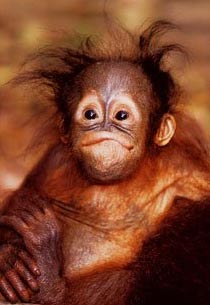
Baby Orangutan
See more about Orangutans

Chimpanzee
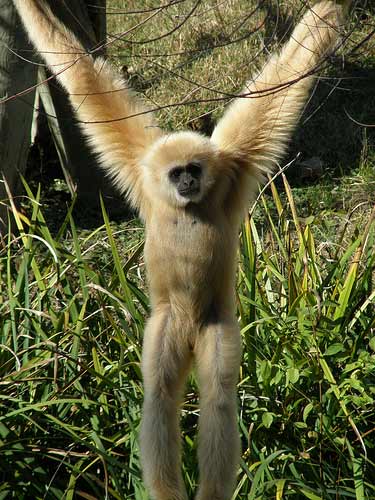
Gibbon
The Gibbon (13 species) - fast, agile, vocal and social, they are closer to monkeys than the great apes.
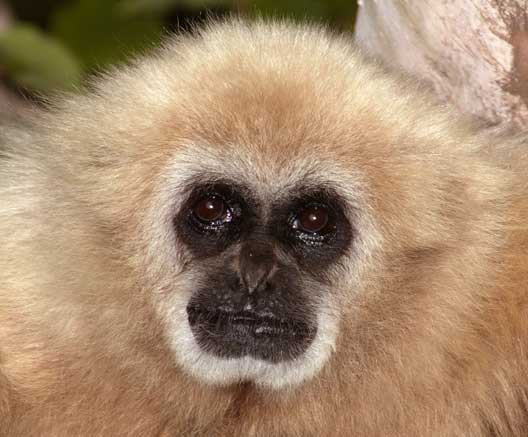
Gibbon Close-up
Old World
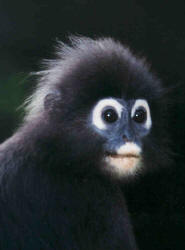
Spectacled Langur
These Langurs are leaf eaters and are also known as the Dusky Leaf Monkey. They are not aggresive although they are territorial and stay in troops with a male leader and many females. They prefer trees and daylight and have good hearing and vision.
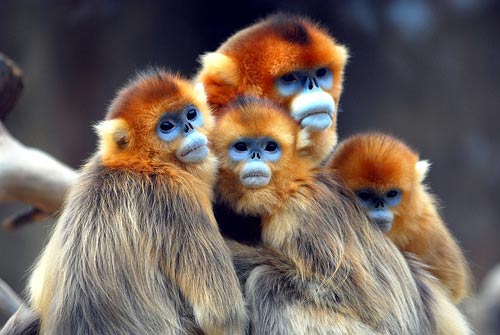
Golden Snub Nose Monkeys
These are some colorful chinese monkeys. They live very high in the trees in secluded densely forested areas, sometimes in very large groups. The fur on their backs can grow to be fairly long.
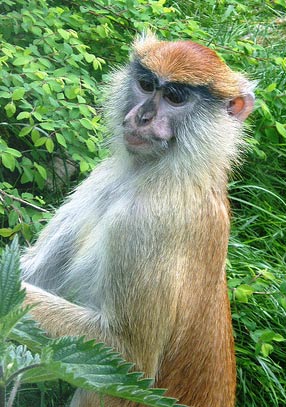
Patas Monkey
The patas monkey is slender with long arms and legs, better suited to walking and running than to moving in the trees. They are very fast on the ground moving up to 55 kph or 34 mph. They do prefer to sleep in trees and will each sleep in their own separate tree. They live in Central Africa and the males have blue scrotums.
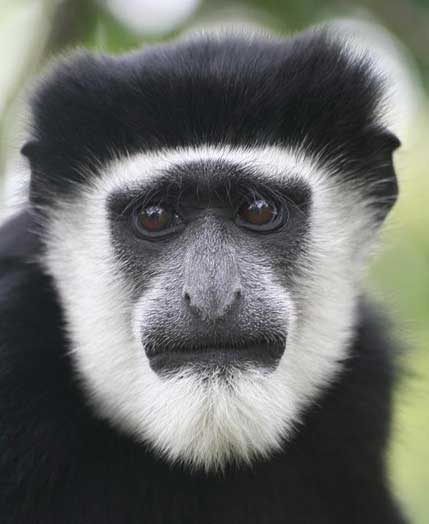
Colobus Monkey
The Colobus is born white and turns black (with white coloring) while still very young. They have no thumbs and prefer treetops and tender leaves in Eastern Africa.
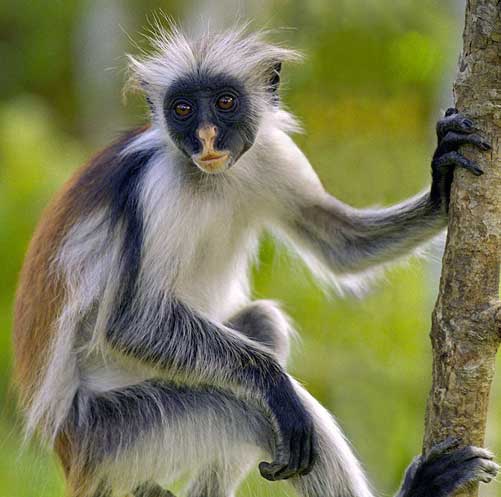
Red Colobus Monkey
The Red Colobus also eats mostly leaves. They can eat from more than 60 different kinds of plants. Sometimes they can share trees with other monkeys since their diet does not overlap with that of the other monkeys.

Young Colobus Guereza

Drill
The Drill is an endangered primate. In the equatorial region of Africa the drill is known as "bushmeat" and eaten. Their habitat has also been largely destroyed. Drills move on the ground and in the lower levels of trees and eat mostly fruit.
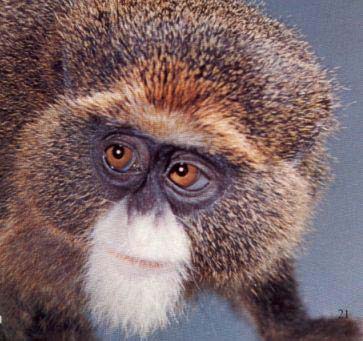
DeBrazzas Monkey
DeBrazza's monkeys employ a variety of gestures to communicate with each other. These include staring, staring with mouth open, head-bobbing, the fearful grimace, yawning and head-shaking. These gestures have to do with displays of aggression or appeasement.
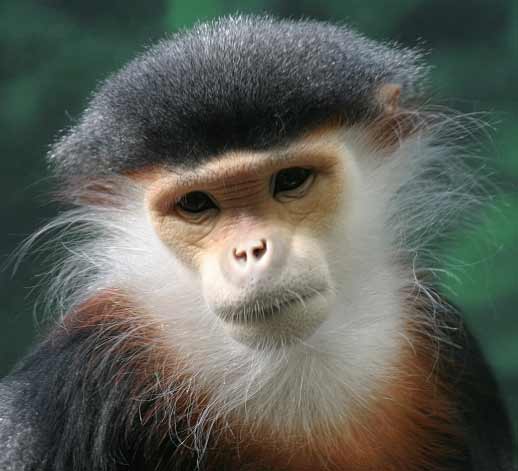
Douc Langur Monkey
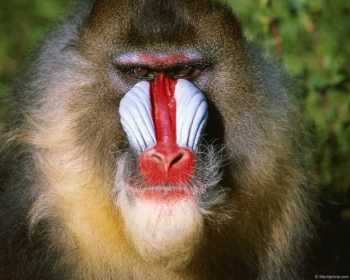
Mandrill
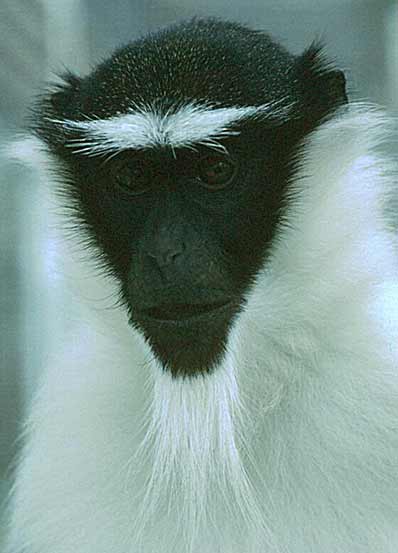
Roloway Monkey
New World
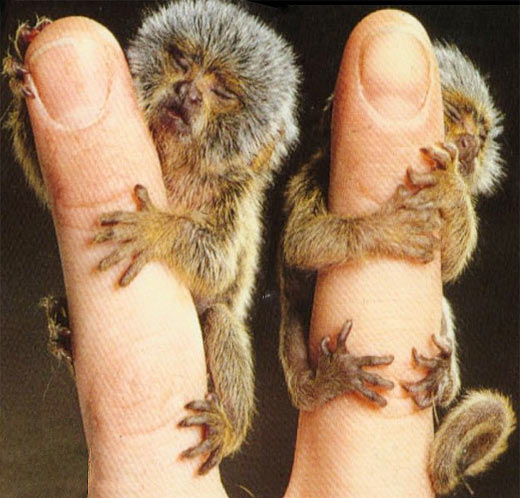
Baby Pygmy Marmosets
See more about Pygmy Marmoset
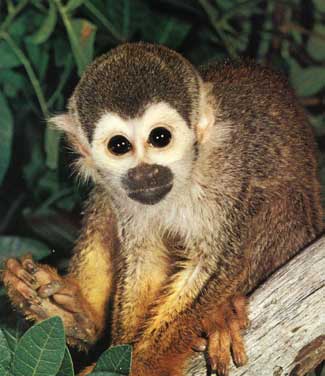
Squirrel Monkey
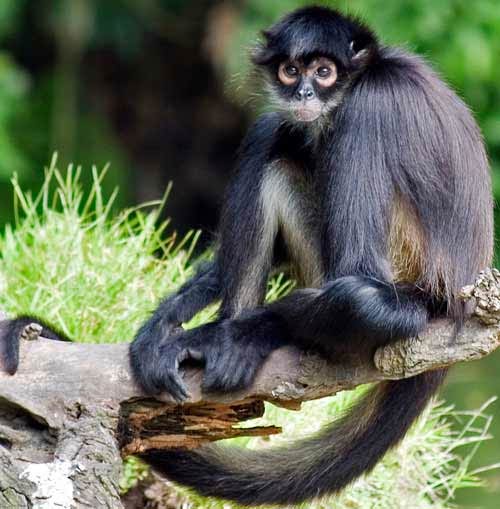
Spider Monkey
With its very long arms the spider monkey may be the most acrobatic of all the monkeys, looping and swinging very long distances.
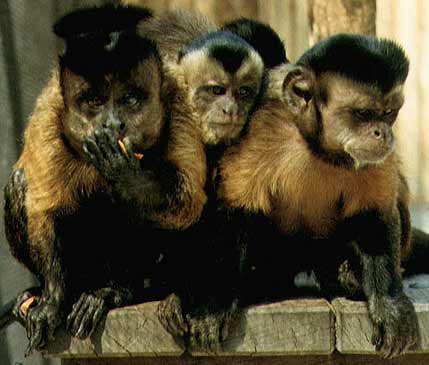
Tufted Capuchins
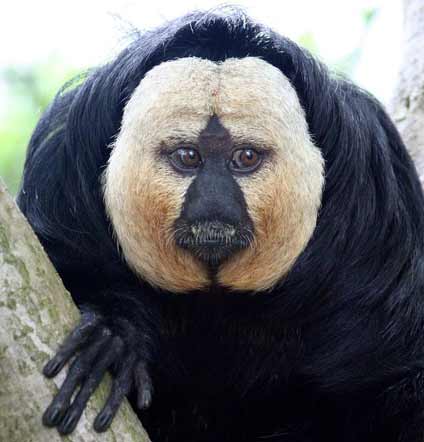
White-faced Saki Monkey

Golden Lion Tamarin
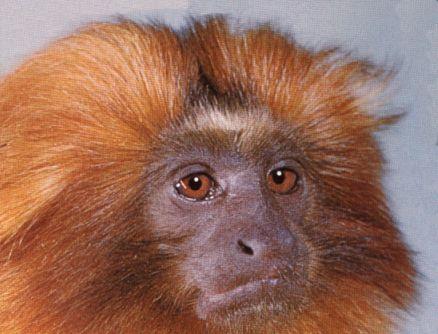
Golden Lion Tamarin Close-up
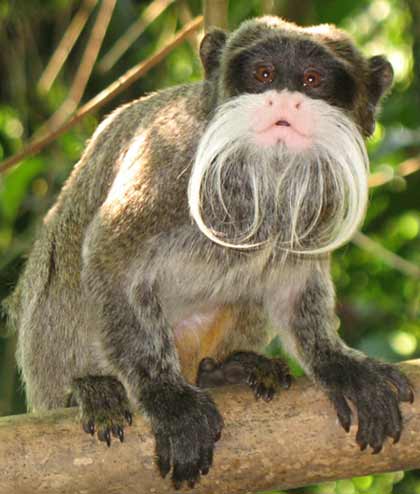
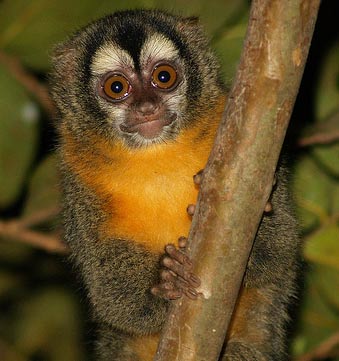
Owl or Night Monkey
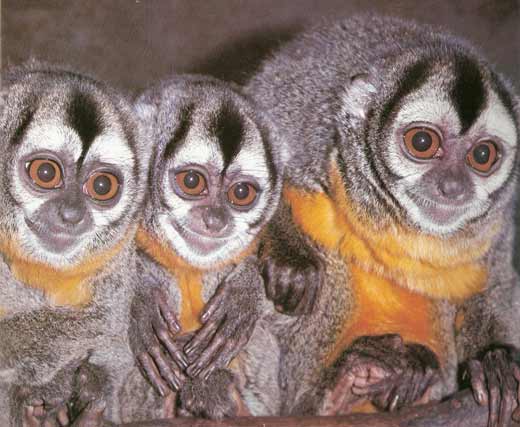
Owl or Night Monkey Family
The owl monkeys are rain forest monkeys that have a bit of an owlish face that always seems to be smiling. They have many different vocalizations, up to 50 or more, including a piercing alarm shriek. They are night eaters, usually in pairs, they go browsing and foraging, eating fruit, leaves, and insects in the dark forest. In the daytime they sleep together in small family groups within hallowed-out trees.
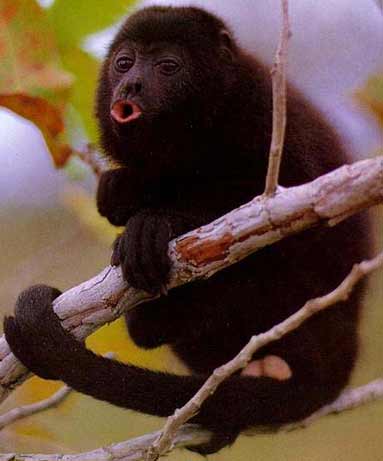
Howler Monkey
Who is the loudest monkey in all the jungle? Thats right, the Howler isn't called that for nothing. Their howl can be heard from 3-4 miles (4-6.5km) away. They are also the largest types of monkeys found in the Americas standing up to 2 feet (0.6m) tall.
Indian Coinage
An Overview
India has been one of the earliest issuers of coins in the world (circa 6 th Century BC). Few countries rival India for the sheer diversity of its coinage be it minting techniques, motifs, sizes, shapes, the metals used or for that matter the monetary history arising from the Monetary Standards India has experienced (Tri-metallism, Bi-metallism, the Silver Standard, the Gold Exchange Standard as well as fiat money).
In history, Indian coins have played a crucial role in documenting political and economic changes over time. Foreign coin hoards found in India throw light on Indian trade patterns in ancient, medieval, and late pre-colonial times. The Motifs on coins have been impacted upon by the cultural ethos of different regions at different time periods.
By this site i attempt to give a sampler of Indian Coins/currencies down the ages and are by no means exhaustive. I am pleased to share with you some of the background history, information and images from my collection. i propose to supplement the more infomatives in the days to come, i always welcome contributions/view of the public/viewers.
Republic India Coinage
India won its independence on 15th August, 1947. During the period of transition India retained the monetary system and the currency and coinage of the earlier period. While Pakistan introduced a new series of coins in 1948 and notes in 1949, India brought out its distinctive coins on 15th August, 1950.
Chronologically, the main considerations influencing the coinage policy of Republic India over time have been:
- The incorporation of symbols of sovereignty and indigenous motifs on independence;
- Coinage Reforms with the introduction of the metric system;
- The need felt from time to time to obviate the possibility of the metallic value of coins rising beyond the face value;
- The cost-benefit of coinisation of currency notes
Independent India Issues could broadly be categorised as The Rupees from 1947-1950. This represented the currency arrangements during the transition period upto the establishment of the Indian Republic. The Monetary System remained unchanged at One Rupee consisting of 192 pies.
1 Rupee = 16 Annas
1 Anna = 4 Pice
1 Pice = 3 Pies
The Anna Series
This series was introduced on 15th August, 1950 and represented the first coinage of Republic India. The King's Portrait was replaced by the Lion Capital of the Ashoka Pillar. A corn sheaf replaced the Tiger on the one Rupee coin. In some ways this symbolised a shift in focus to progress and prosperity. Indian motifs were incorporated on other coins. The monetary system was largely retained unchanged with one Rupee consisting of 16 Annas.
The Decimal Series
Denomination Metal Obverse Reverse Rupee One Nickel
Other Distributions
Other DistributionsHalf Rupee Nickel
Other Distributions
Other DistributionsQuarter Rupee Nickel
Other Distributions
Other DistributionsTwo Anna Cupro-Nickel
See Other Distributions
See Other DistributionsOne Anna Cupro-Nickel
See Other Distributions
See Other DistributionsHalf Anna Cupro-Nickel
See Other Distributions
See Other DistributionsOne Pice Bronze
See Other Distributions
See Other DistributionsThe move towards decimalisation was afoot for over a century. However, it was in September, 1955 that the Indian Coinage Act was amended for the country to adopt a metric system for coinage. The Act came into force with effect from 1st April, 1957. The rupee remained unchanged in value and nomenclature. It, however, was now divided into 100 'Paisa' instead of 16 Annas or 64 Pice. For public recognition, the new decimal Paisa was termed 'Naya Paisa' till 1st June, 1964 when the term 'Naya' was dropped.
Naya Paisa Series 1957-1964
Denomination Metal / Weight / Shape / Size Coin Rupee One Nickel
10 gms
Circular
28 mm
Other DistributionsFifty Naye Paise Nickel
5 gms
Circular
24 mm
Other DistributionsTwenty Five Naye Paise Nickel
2.5 gms
Circular
19 mm
Other DistributionsTen Naye Paise Cupro-Nickel
5 gms
Eight Scalloped
23 mm (across scallops)
Other DistributionsFive Naye Paise Cupro-Nickel
4 gms
Square
22 mm (across corners)
See Other DistributionsTwo Naye Paise Cupro-Nickel
3 gms
Eight Scalloped
18 mm (across scallops)
See Other DistributionsOne Naya Paisa Bronze
1.5 gms
Circular
16 mm
See Other DistributionsWith commodity prices rising in the sixties, small denomination coins which were made of bronze, nickel- brass, cupro-nickel, and Aluminium-Bronze were gradually minted in Aluminium. This change commenced with the introduction of the new hexagonal 3 paise coin. A twenty paise coin was introduced in 1968 but did not gain much popularity.
Aluminium Series 1964 onwards
Denomination Metal / Weight / Shape / Size Coin One Paisa Aluminium-Magnesium
0.75 gms
Square
17 mm (Daigonal)
See Other DistributionsTwo Paise Aluminium-Magnesium
1 gm
Scalloped
20 mm (across scallops)
See Other DistributionsThree Paise Aluminium-Magnesium
1.25 gms
Hexagonal
21 mm (Diagonal)
See Other DistributionsFive Paise Aluminium-Magnesium
1.5 gms
Square
22 mm (Diagonal)
Other DistributionsTen Paise Aluminium-Magnesium
2.3 gms
Scalloped
26 mm (across scallops)
Other DistributionsTwenty Paise Aluminium-Magnesium
2.2 gms
Hexagonal
26 mm (diagonal)
24.5 mm (across flats)
See Other DistributionsOver a period of time, cost benefit considerations led to the gradual discontinuance of 1, 2 and 3 paise coins in the seventies; Stainless steel coinage of 10, 25 and 50 paise, was introduced in 1988 and of one rupee in 1992. The very considerable costs of managing note issues of Re 1, Rs 2, and Rs 5 led to the gradual coinisation of these denominations in the 1990s.
Contemporary Coins
| Denomination | Metal | Weight | Diameter | Shape |
 See Other Distributions | Silver | - gms | 23 mm | Circular |
 See Other Distributions | Silver | - gms | 23 mm | Circular |
 See Other Distributions | Silver | - gms | 23 mm | Circular |
 See Other Distributions | Silver | - gms | 23 mm | Circular |
 See Other Distributions | Cupro-Nickel and Silver | - gms | 23 mm | Circular |
 See Other Distributions | Cupro-Nickel | 9.00 gms | 23 mm | Circular |
 Other Distributions | Cupro-Nickel | 6.00 gms | 26 mm | Eleven Sided |
| Ferratic Stainless Steel | 4.85 gms | 25 mm | Circular | |
 Other Distributions | Ferratic Stainless Steel | 3.79 gms | 22 mm | Circular |
 Other Distributions | Ferratic Stainless Steel | 2.83 gms | 19 mm | Circular |
| Ferratic Stainless Steel | 2.00 gms | 16 mm | Circular |

 Woodpeckers are simply impressive birds. I am pleased whenever I can photograph one. I felt particularly lucky to photograph this pair of White-naped Woodpecker in India (left). But these were not a "pair" in the traditional sense — the yellow-crowned female was feeding the red-crowned bird. I think the red-crowned one was her now full-grown fledgling. She had been working a long time to get out the thick grub, and the shot was taken just before she shoved the big grub down the youngster's gullet.
Woodpeckers are simply impressive birds. I am pleased whenever I can photograph one. I felt particularly lucky to photograph this pair of White-naped Woodpecker in India (left). But these were not a "pair" in the traditional sense — the yellow-crowned female was feeding the red-crowned bird. I think the red-crowned one was her now full-grown fledgling. She had been working a long time to get out the thick grub, and the shot was taken just before she shoved the big grub down the youngster's gullet. Woodpeckers are a large family of similarly designed birds found in forested areas around the globe. They have evolved to deal with chiseling wood, including "shock-absorber" head musculature, extremely long tongues, and stiff tail feathers helping them perch upright on trees (Winkler & Christie 2002). Woodpeckers are often a "core species" of the woodland avifauna [except in two major areas that don't have any woodpeckers: Australasia and Madagascar]. I am very fond of the woodpeckers that live in my yard on the Monterey Peninsula. This male Nuttall's Woodpecker (right) was bringing food to nest hole just outside our bedroom window in June 2002. We had left a tall stub of this dead Monterey pine when we had to remove the top-heavy canopy for safety reasons, and the next year we were rewarded with a pair of Nuttall's that fledged a youngster. The tree stub would eventually crumble in high winter winds a few years later, but "our" family of these attractive little woodpeckers still frequents the neighborhood. Hairy Woodpecker Picoides villosus also nests occasionally in the yard, as do a small party of Acorn Woodpeckers.
Woodpeckers are a large family of similarly designed birds found in forested areas around the globe. They have evolved to deal with chiseling wood, including "shock-absorber" head musculature, extremely long tongues, and stiff tail feathers helping them perch upright on trees (Winkler & Christie 2002). Woodpeckers are often a "core species" of the woodland avifauna [except in two major areas that don't have any woodpeckers: Australasia and Madagascar]. I am very fond of the woodpeckers that live in my yard on the Monterey Peninsula. This male Nuttall's Woodpecker (right) was bringing food to nest hole just outside our bedroom window in June 2002. We had left a tall stub of this dead Monterey pine when we had to remove the top-heavy canopy for safety reasons, and the next year we were rewarded with a pair of Nuttall's that fledged a youngster. The tree stub would eventually crumble in high winter winds a few years later, but "our" family of these attractive little woodpeckers still frequents the neighborhood. Hairy Woodpecker Picoides villosus also nests occasionally in the yard, as do a small party of Acorn Woodpeckers.  More fine woodpeckers occur in the red fir/lodgepole pine forests of the Sierra Nevada. There is almost nothing so pleasant on a lazy summer day in the mountains as listening for the tapping of woodpeckers and chasing each one down. The ultimate highlight is finding a rare Black-backed Woodpecker (left); this male was accompanied by a young fledgling.
More fine woodpeckers occur in the red fir/lodgepole pine forests of the Sierra Nevada. There is almost nothing so pleasant on a lazy summer day in the mountains as listening for the tapping of woodpeckers and chasing each one down. The ultimate highlight is finding a rare Black-backed Woodpecker (left); this male was accompanied by a young fledgling.



 With over two hundred species around the world, there is tremendous diversity among the woodpeckers. The two wrynecks of the Old World are included within the family, and there are well over two dozen species of tiny piculets in the world's tropics. There are also huge forest-dominating species in the several genera, including the genera Dryocopus and Campephilus.
With over two hundred species around the world, there is tremendous diversity among the woodpeckers. The two wrynecks of the Old World are included within the family, and there are well over two dozen species of tiny piculets in the world's tropics. There are also huge forest-dominating species in the several genera, including the genera Dryocopus and Campephilus.





























